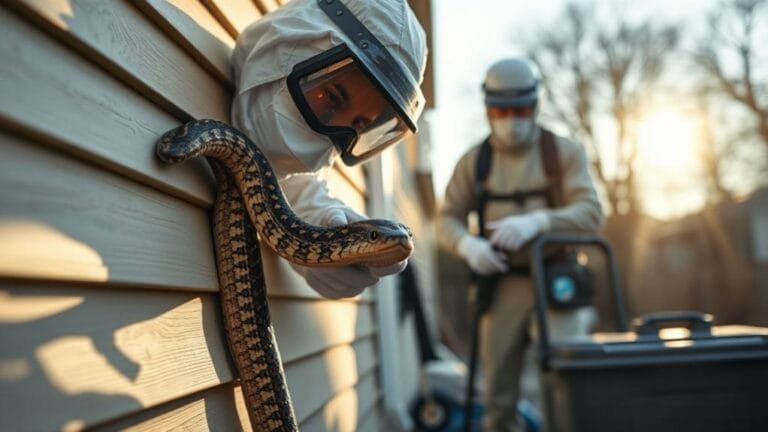Are you a dog owner worried about the potential threat of king snakes to your furry companion? Well, fret not! Let’s dive into the fascinating world of these reptiles and discover whether they pose a danger to your beloved pooch.
King snakes, with their vibrant colors and non-venomous nature, rely on constriction to capture prey. However, their defensive tactics may confuse and concern pet owners.
So, join us as we unravel the truth about king snakes and explore the precautions you can take to ensure your dog’s safety and freedom.
Key Takeaways
Table of Contents
- King snakes are nonvenomous and pose no direct danger to dogs.
- However, dogs may provoke or corner a king snake, increasing the risk of being bitten.
- King snakes have various defense mechanisms, including mimicking the appearance and behavior of venomous snakes and releasing a foul-smelling musk.
- It is important for pet owners to be aware of the presence of king snakes in their area and take precautions to keep their dogs away from them.
The Nonvenomous Nature of King Snakes
King snakes, including common king snakes, are nonvenomous reptiles, so they pose no direct danger to your dog. Understanding snake behavior and observation can help you ensure the safety of your furry friend.
When encountering a king snake, it’s important to remember that they’re generally docile and prefer to avoid confrontation. If you come across one, it’s best to observe it from a safe distance.
Avoid handling the snake unless you’re trained in snake handling techniques. Attempting to handle a snake without proper knowledge can result in stress for both you and the snake.
Understanding King Snake Behavior and Diet
Understanding their behavior and diet can help you better navigate encounters with these reptiles and ensure the safety of your pets.
King snakes are known for their hunting behavior and diverse diet. These snakes are constrictors, meaning they squeeze their prey to subdue it. They primarily feed on rodents, birds, and other small reptiles. King snakes are skilled hunters that rely on their sense of smell to locate their prey.
They’re adaptable and can be found in various habitats such as forests, grasslands, and deserts. It’s important to understand the habitats favored by king snakes to minimize encounters with them and reduce the risk to your pets.
Identifying and Preventing Dog Bites From King Snakes
To prevent dog bites from these reptiles, it’s important to take necessary precautions and be aware of the environment and potential snake habitats. Here are three key steps to snakebite prevention:
Take your dog to snake avoidance training classes: These classes teach dogs to recognize and avoid snakes, reducing the risk of bites.
Stay in safe areas with no snake activity: Avoid areas known to have high snake populations, such as tall grass, rocky areas, or bodies of water.
Keep your dog on a leash to control their movements: By keeping your dog close, you can prevent them from wandering into snake-infested areas.
If your dog does get bitten by a snake, it’s essential to seek veterinary assistance immediately. Remember, not all snakes are venomous, but it’s crucial to identify the snake and treat the bite accordingly.
Taking these precautions and being prepared can help keep your dog safe from snakebites.
Snake Avoidance Training for Dogs
Snake avoidance training for dogs is a crucial step in ensuring their safety. By exposing dogs to the sight, sound, and smell of snakes in a controlled environment, they can learn to recognize and avoid them in the wild.
This type of training utilizes positive reinforcement techniques and has been proven to be effective in preventing snake bites, ultimately benefiting the well-being and longevity of your furry companions.
Importance of Early Training
If you want to ensure the safety of your dog around king snakes, early training is crucial. By implementing early socialization and positive reinforcement training, you can help your dog develop the skills needed to navigate encounters with these reptiles.
Here are three key reasons why early training is important:
Familiarity: Introducing your dog to different environments, including areas where king snakes may be present, helps them become accustomed to the sights, sounds, and smells associated with these creatures.
Response Control: Teaching your dog basic obedience commands, such as ‘leave it’ or ‘come,’ can be invaluable in redirecting their attention away from king snakes and preventing potential confrontations.
Confidence Building: Exposing your dog to controlled situations with king snakes, under the guidance of a professional trainer, can help build their confidence and reduce fear or aggression.
Techniques and Effectiveness
Learning effective techniques for managing encounters with king snakes can greatly enhance your ability to keep yourself and your pets safe. When it comes to snakebite prevention, it’s important to be proactive and take necessary precautions.
- Avoiding areas known for snake activity and keeping your dog on a leash can minimize the risk of encounters. Clearing overgrown brush in your backyard can also reduce hiding places for snakes.
If a snakebite does occur, it’s crucial to identify the snake that bit your dog and treat the bite as an open wound. Keep a close eye on your dog’s condition and seek veterinary assistance if needed. Remember, king snakes are nonvenomous, but other snakes may require specific treatment.
Benefits for Dog Safety
To keep your furry friend safe, understanding the benefits of snake identification and avoidance is essential. Here are three reasons why snake avoidance training and early training techniques can greatly benefit your dog’s safety:
Increased Awareness: Through snake avoidance training, your dog will learn to recognize and avoid potential snake encounters. This will help prevent them from getting too close or engaging with snakes, reducing the risk of bites.
Quick Response: Early training techniques can teach your dog to respond to snake encounters by immediately retreating and seeking your guidance. This quick response can be crucial in preventing a potentially dangerous situation.
Peace of Mind: By providing your dog with snake avoidance training, you can have peace of mind knowing that they’re better equipped to navigate snake-infested areas. This freedom allows you to enjoy outdoor adventures with your furry companion without constant worry.
Creating a Safe Environment for Dogs and King Snakes
Ensure your backyard is free of overgrown brush and provides no hiding places for king snakes, creating a safe environment for your dogs.
Understanding snake behavior and implementing proper dog training techniques are essential for keeping your furry friends protected.
By clearing your backyard of overgrown brush, you eliminate potential hiding spots for king snakes, reducing the risk of encounters. Additionally, teaching your dogs to avoid snakes through training can be beneficial.
Dogs should be kept on a leash when outside to control their movements and prevent them from exploring areas where snakes may be present.
By being aware of your surroundings and potential snake habitats, you can significantly reduce the chances of snake bites and create a safer environment for your beloved pets.
| Dog Training Techniques | Understanding Snake Behavior |
|---|---|
| Leash control | Snakes’ hunting methods |
| Avoidance training | Defensive behaviors |
| Environmental awareness | Preferred habitats |
Treating Snakebites: What to Do if Your Dog Is Bit
If your dog is bit by a snake, it’s important to take immediate action.
First, try to identify the snake species if possible, as this information can help determine the appropriate treatment.
Monitor your dog’s condition closely for any signs of distress or worsening symptoms.
Immediate Veterinary Assistance
If your dog gets bitten by a snake, regardless of its species, seek immediate veterinary attention. Snakebites can be dangerous and may require prompt medical intervention.
Here is what you need to know about snakebite first aid, symptoms and treatment, and preventing snakebite accidents:
Snakebite first aid:
- Keep your dog calm and restrict their movement.
- Don’t attempt to suck out the venom or apply tourniquets.
- Wash the wound gently with mild soap and water.
Symptoms and treatment:
- Look out for swelling, bruising, and pain at the bite site.
- Your dog may experience weakness, vomiting, or difficulty breathing.
- The veterinarian may administer antivenom and provide supportive care.
Preventing snakebite accidents:
- Keep your dog on a leash during walks.
- Avoid tall grass and rocky areas where snakes may hide.
- Consider snake avoidance training for your dog.
Identifying the Snake Species
Now, let’s delve into the important task of identifying the snake species. It’s crucial to be able to differentiate between venomous and non-venomous snakes for the safety of both you and your beloved pet. However, there are some misconceptions about king snakes that need to be addressed.
Snake identification techniques involve observing physical characteristics such as color patterns, body shape, and head shape. It’s important to remember that not all snakes with vibrant colors are venomous.
King snakes, for example, are non-venomous despite their striking appearance. They’re constrictors and kill their prey by constriction rather than venom. So, if you come across a king snake, there’s no need to panic or fear for your dog’s safety.
To avoid any misunderstandings, it’s advisable to consult local snake experts or herpetologists who can accurately identify the snake species. This will help promote coexistence and dispel unnecessary fear surrounding these fascinating creatures.
Monitoring Dog’s Condition
Keep a close eye on your furry friend’s condition after encountering a snake to ensure their well-being. It’s essential to monitor your dog’s recovery and watch for any symptoms that may indicate a problem.
Here are three key things to look out for during your dog’s recovery:
Swelling and Redness: Check the bite area for any signs of swelling, redness, or inflammation. These could be indications of an allergic reaction or infection and should be monitored closely.
Lethargy and Weakness: Keep an eye on your dog’s energy levels. If they seem unusually tired or weak, it could be a sign of venomous snakebite. Seek veterinary assistance immediately in these cases.
Changes in Behavior: Notice any changes in your dog’s behavior, such as loss of appetite, vomiting, or difficulty breathing. These could be signs of a more severe reaction or internal injury.
Common Misconceptions: King Snakes Vs. Venomous Snakes
Don’t confuse common king snakes with venomous snakes, as they’re harmless to dogs and cats.
There are some misconceptions about king snakes that need to be debunked, especially when it comes to their potential danger to pets. Common king snakes are non-venomous reptiles found in North and Central America. They’ve vibrant and distinct color patterns, making them visually striking.
These snakes are constrictors, meaning they squeeze their prey to subdue it. While they may mimic the appearance and behavior of venomous snakes when threatened, their bite isn’t venomous or harmful to dogs and cats.
It’s important for pet owners to be aware of the difference between king snakes and venomous snakes to avoid unnecessary fear or harm to these harmless reptiles.
Coexistence With King Snakes: Tips for Pet Owners
If you’ve pets, it’s important to learn how to coexist with common king snakes in your area. These nonvenomous snakes are generally harmless to dogs, but it’s still crucial to take precautions to ensure the safety of your furry friends.
Here are three tips to help you coexist with king snakes and keep your pets protected:
Snake-proof your backyard: Clear any overgrown brush or debris that could serve as hiding places for snakes. This will reduce the likelihood of a snake encounter in your own yard.
Introduce dogs to snakes gradually: Consider enrolling your dog in snake avoidance training classes. These classes teach dogs to recognize and avoid snakes, reducing the risk of a potentially harmful encounter.
Stay vigilant and aware: Be mindful of your surroundings and potential snake habitats when walking your dog. Keep your dog on a leash to maintain control and prevent them from investigating snake territories.
Importance of Proper Snake Identification for Dog Safety
It’s essential for you as a pet owner to accurately identify snakes to ensure the safety of your furry companions. Proper snake identification techniques are crucial in promoting safe interactions between dogs and snakes.
One common snake species that pet owners often encounter is the king snake. King snakes are non-venomous reptiles found in various regions of North and Central America. They’re known for their vibrant color patterns and are constrictors, meaning they squeeze their prey to subdue it.
While they may mimic the appearance and behavior of venomous snakes when threatened, their bites aren’t venomous or harmful to dogs. However, it’s important to remember that misidentification can lead to unnecessary fear or harm to non-venomous snakes.
Consulting local snake experts or herpetologists can help ensure accurate identification and promote coexistence between dogs and snakes.
Frequently Asked Questions
Can King Snakes Harm or Kill Dogs With Their Constriction?
King snakes are unlikely to harm or kill dogs with their constriction. However, it’s important to understand snake behavior and body language to prevent snakebites. Learn how to keep your dog safe and recognize signs of danger.
Are King Snakes Aggressive Towards Dogs, and Will They Attack if Provoked?
King snakes are generally not aggressive towards dogs and will typically try to escape rather than attack. Differentiating between king snakes and venomous snakes is important.
Can Dogs Be Trained to Avoid King Snakes?
Yes, dogs can be trained to avoid king snakes. Through snake avoidance training classes, dogs can learn to recognize the scent and behavior of king snakes and avoid them, reducing the risk of encounters and potential bites.
What Should I Do if My Dog Gets Bitten by a King Snake?
If your dog gets bitten by a king snake, there are a few steps you can take. First, identify the snake. Treat the bite as an open wound and monitor your dog’s condition. Seek veterinary assistance if unsure.
How Can I Differentiate Between a King Snake and a Venomous Snake for the Safety of My Dog?
Differentiating between a king snake and a venomous snake is like telling the difference between a harmless friend and a dangerous enemy. Common misconceptions about king snakes and their danger to dogs should be dispelled through accurate information and education.
Conclusion
In conclusion, while king snakes may pose a potential threat to dogs, their nonvenomous nature and reliance on constriction make them much less dangerous compared to venomous snakes.
By understanding their behavior, taking necessary precautions, and educating ourselves about proper snake identification, we can create a safe environment for our dogs and coexist with king snakes peacefully.
Remember, knowledge and awareness are key to ensuring the safety and well-being of our beloved canine companions.








